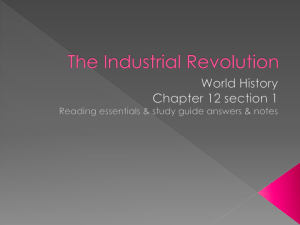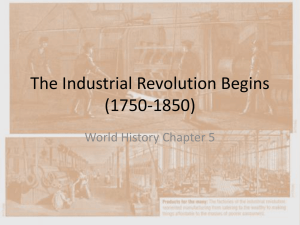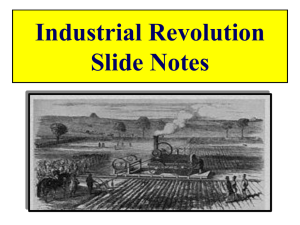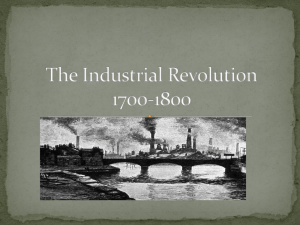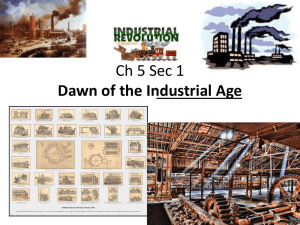From the Industrial Revolution to Green Chemistry
advertisement
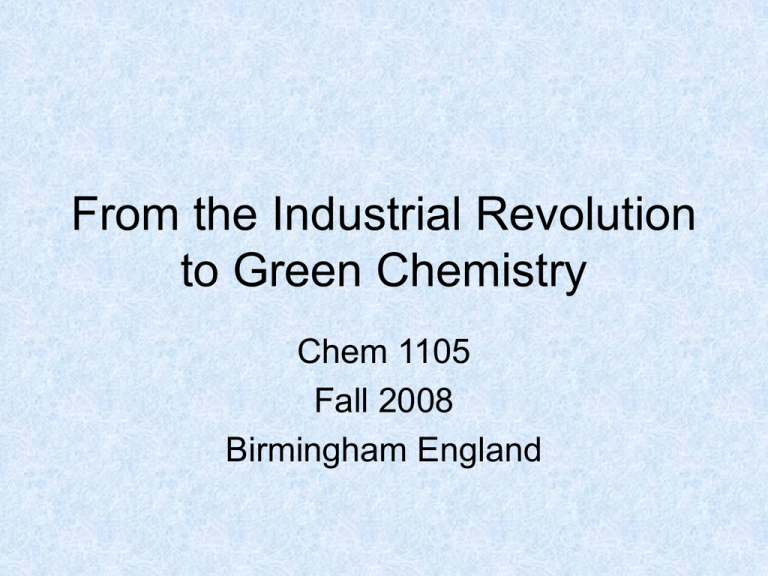
From the Industrial Revolution to Green Chemistry Chem 1105 Fall 2008 Birmingham England The Industrial Revolution • • • • • What? When? Where? Why? Who? What? • A period during which major fundamental and sustained technological and social changes occurred. • These changes were associated with manufacturing, agriculture, economic policies, social structures, commerce and transportation. When? • A 100-year period starting in 1760 in Britain. • This date is somewhat arbitrary as nearly two centuries of gradual changes preceded 1760. • In subsequent years, the consequences of the Industrial Revolution spread to Europe and North America, and then around the world. Where? • Ironbridge in Shropshire England (about 1.5 - 2 hours from Birmingham) is called the birthplace of the Industrial Revolution. • Currently there are ten museums at Ironbridge Gorge that focus on the period in Britain called the Industrial Revolution. Why? And Why in Great Britain? • Numerous and complicated causes many of which are still debated. • Political organizations and traditions, natural and financial resources, stable government, colonies, naval strength, decline of epidemics, increase in lifespan, established markets, work ethic, technological innovations and scientific discoveries, geography, entrepreneurial ethic and receptiveness to change are among the proposed causes of the Industrial Revolution. Who? • • • • Technology: Inventors, scientists Agriculture: farmers, land owners Business: industrialists, manufacturers Transportation: builders of roads, canals, rail lines • Policy: economics, social, legal, health care, labor, trade What Will I Study? • Technological Innovations – Scientific basis for these innovations – The lives of the scientists and innovators – Impact of the innovations • Green Chemistry – Definition – Current solutions to deleterious effects Focus of this Course (1) • Technological innovations – Iron and Metallurgy – Steam Engine – Chemical Industry – Textiles, Tiles and China • Scientific basis for these innovations • Innovators and scientists, especially those who worked and lived in the Midlands Field Trips • Ironbridge Gorge (group trip) • Soho House • Birmingham Canals Focus of this Course (2) • Green Chemistry: Current chemical and engineering solutions to undesirable byproducts of industrialization – Air Pollution – Land Pollution – Disease – Water Contamination The Big Picture • From an agrarian economy to industrialization. • The big three: textiles, iron and the steam engine. • What happened in Birmingham • Industrialization in the 21st century Agrarian Economy • 1700: 80% of England’s population earned its livelihood from the land. • 1800: This had dropped to 40% even as the population doubled. • http://www.historyguide.org/intellect/lecture 17a.html Increased Production of Food and Raw Material • Enclosure movement (increase in private land ownership). • Crop rotation (more crops for food and animals). • Improvements in – farm implements (wood to metal) – Irrigation - Insect control – Livestock breeding – New crops - Farming methods Consequences of Increased Crop Yield • Increased food production allowed the migration from farm to industrial centers thus sustaining a growing manufacturing economy. • Increased agricultural raw materials allowed growth of industrials producing consumer products (with the development of new machinery; e.g. textiles). • Substantial growth in economy, trade, industrial base. Textiles • Pre-IR: Textile production was a cottage industry with sheep raised on small farms and artisans spinning and weaving wool into cloth. • Transition to textile manufacturing involved task specialization as machines (flying shuttle, roller spinner, jenny) were invented, improved and distributed. • IR: Textile factories became larger, multiplied and spread. Coal Mining • Pre-IR: Mining coal was a labor intensive, non-mechanized and very dangerous occupation. • Introduction of carts on rails, improved ventilation and lighting, and mechanization of coal transport (↑ and →) led to increased coal production. It was still a very hazardous job. • Iron production depended on coal. Iron Mining • Iron was the major raw material for making tools, structures and machinery. • Pre-IR: Iron + charcoal (from wood) low grade, impure and brittle material • IR: Iron + coke (from coal) superior pig iron product • http://www.ironbridge.org.uk/ Iron Bridge Transportation • Pre-IR: Roads, canals and rivers were primary transportation routes. • IR: Railroads (1000 miles of RR tracks in 1836 and 7000 miles in 1852) and expansion of existing canal system were designed to move raw materials and products, thus contributing to economic growth and increases in population, especially in towns. • http://www.birmingham.gov.uk/canals.bcc See especially History of the Canals link. Steam Engine • Pre-IR: There was limited use of steam engines. • IR: The improvement of the steam engine in 1778 by James Watt “was undoubtedly the greatest technical achievement of the Industrial Revolution”. • Watt increased engine efficiency four-fold. As a result, industrialization accelerated and spread to all aspects of human activity. • http://www.egr.msu.edu/~lira/supp/steam/ • http://www.saburchill.com/history/chapters/ IR/018.html James Watt Statue outside Birmingham Central Library • http://en.wikipedia.org/wiki/Watt,_James References • http://www.yale.edu/ynhti/curriculum/guide s/1981/2/81.02.06.x.html • http://www.birmingham.gov.uk/canals.bcc • http://www.historyguide.org/intellect/lecture 17a.html • http://www.ironbridge.org.uk/ • http://www.egr.msu.edu/~lira/supp/steam/ References • http://www.saburchill.com/history/chapters/ IR/018.html • See also references in syllabus

